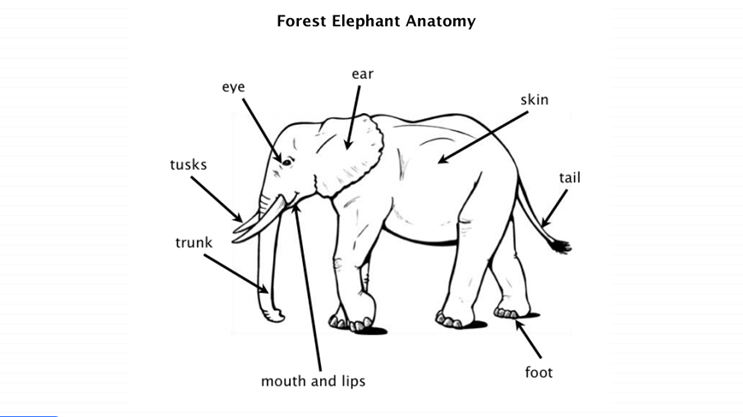Elephants are among the most majestic and fascinating creatures on Earth. Known for their impressive size, intelligence, and social behavior, these animals rely on their unique anatomy to thrive in various environments. In this article, we will explore the key body parts of an elephant and their functions, showcasing how these features contribute to their survival and daily life.
A Body Part of A Elephant

1. Trunk: The Ultimate Multifunctional Tool
The trunk is arguably the most iconic and versatile part of an elephant’s body. It is an elongated fusion of the upper lip and nose, containing over 40,000 muscles. This incredible appendage serves multiple purposes:
- Breathing and Smelling: Elephants use their trunks to inhale air and detect scents. Their sense of smell is remarkably acute, enabling them to locate water sources and food over great distances.
- Drinking: While the trunk itself does not drink water, it acts as a siphon, drawing water and then squirting it into the elephant’s mouth.
- Feeding: The trunk acts as a hand, grasping vegetation and bringing it to the mouth. Elephants can use their trunks with remarkable precision to pick small objects or strip leaves from branches.
- Communication: Elephants use their trunks to touch, caress, or express dominance within their herd. They also produce sounds like trumpeting, which are essential for communication.
- Defense and Interaction: The trunk can be a defensive tool, used to swat away threats or interact with other animals and objects in their environment.
2. Tusks: Tools of Strength and Defense
Tusks are elongated incisors made of ivory. While both male and female African elephants may have tusks, only some Asian male elephants possess them. Tusks serve several critical functions:
- Digging: Elephants use their tusks to dig for water, minerals, and roots in the ground.
- Foraging: Tusks help strip bark from trees and break branches, providing access to food.
- Defense: In confrontations with predators or rivals, tusks act as formidable weapons.
- Marking Territory: Elephants use their tusks to scrape trees or dig in the soil, leaving visual and scent markers.
- Social Signaling: Larger and more robust tusks often signify strength and dominance, playing a role in mating dynamics.
3. Ears: Cooling Mechanism and Communication
Elephants’ large, flapping ears are not just for hearing; they play a crucial role in thermoregulation and social interaction:
- Temperature Regulation: The thin skin of the ears is lined with blood vessels. By flapping their ears, elephants cool the blood flowing through them, helping to regulate their body temperature in hot climates.
- Hearing: Elephants have excellent hearing, and their large ears amplify sound waves, enabling them to detect low-frequency rumbles and distant calls.
- Communication: Elephants express emotions like anger, excitement, or curiosity by moving their ears in specific ways.
4. Legs and Feet: Power and Stability
The sturdy legs of an elephant support its massive weight, which can range from 2,500 to 6,000 kilograms, depending on the species. Their feet are uniquely adapted to their size and environment:
- Weight Distribution: The column-like structure of the legs ensures even weight distribution, enabling elephants to walk silently despite their size.
- Cushioning Pads: The soles of an elephant’s feet have a thick, spongy pad that absorbs shock and provides traction on various terrains.
- Digging and Scraping: Elephants use their feet to dig shallow holes for water or to loosen soil.
- Communication: Elephants can detect seismic vibrations through their feet, allowing them to sense distant movements or calls.
5. Skin: Protective Armor
An elephant’s skin is thick, ranging from 2 to 4 centimeters, but surprisingly sensitive. Its functions include:
- Protection: The tough skin acts as a shield against injuries, insect bites, and harsh environmental conditions.
- Thermoregulation: Wrinkles and folds in the skin increase surface area, helping retain water and cool the body.
- Sensory Reception: Despite its toughness, elephant skin is sensitive to touch and temperature, enabling them to feel even a gentle breeze.
- Camouflage and Defense: Elephants often coat themselves with mud or dust to protect their skin from the sun and parasites.
6. Tail: A Swatter and Social Tool
The tail of an elephant might seem minor compared to other body parts, but it serves essential purposes:
- Insect Repellent: The tuft of hair at the end of the tail is used to swat away flies and other pests.
- Social Interaction: Elephants often use their tails to communicate affection or signal distress to their herd members.
7. Eyes: Modest Yet Effective Vision
Elephants have relatively small eyes for their size, but they are adapted for their needs:
- Day and Night Vision: Their eyesight is moderate during the day but improves in low light, aiding nocturnal activity.
- Protective Features: Long lashes and a third eyelid protect their eyes from dust and debris.
8. Mouth and Teeth: Tools for Feeding
An elephant’s mouth and teeth are vital for their herbivorous diet:
- Molars: Elephants have four large molars at a time, which are replaced six times throughout their lives. These teeth grind tough plant material.
- Tongue: The tongue helps manipulate food within the mouth, working in conjunction with the trunk.
9. Internal Organs: Digestive and Cardiovascular Efficiency
Elephants have a specialized internal anatomy to support their large size and plant-based diet:
- Stomach and Intestines: Their digestive system is designed to process large amounts of fibrous vegetation, although only about 50% of their intake is efficiently digested.
- Heart: The elephant’s heart weighs between 12 and 21 kilograms and pumps blood efficiently throughout their massive bodies.
10. Brain: The Seat of Intelligence
Elephants have the largest brain of any land animal, weighing 4.5-5.5 kilograms. This large brain supports:
- Memory: Elephants are known for their excellent memory, which helps them recall water sources and migration routes.
- Problem-Solving: Their intelligence enables them to use tools, navigate complex environments, and adapt to challenges.
- Social Behavior: Elephants exhibit empathy, mourning, and cooperative behavior, reflecting their advanced cognitive abilities.
Conclusion
Every part of an elephant’s body is uniquely adapted to its environment and lifestyle. From the versatile trunk to the massive legs and intricate internal systems, these features allow elephants to survive and thrive in the wild. Understanding the anatomy and functions of these gentle giants helps us appreciate their complexity and reinforces the importance of conserving their habitats for future generations.


